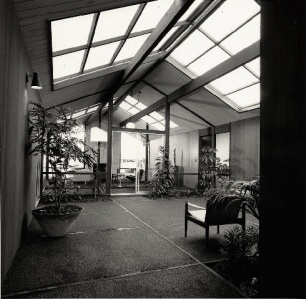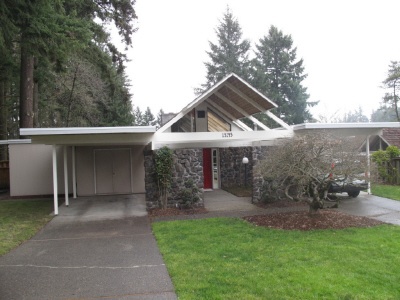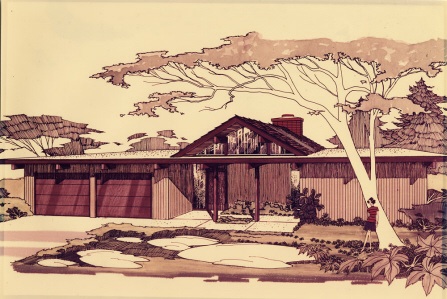These were the Beatniks of housing. They turned their backs to society – and streets and neighbors – to focus on individual backyard havens. Walls of glass invited the outdoors in. Ceilings soared. Massive wood beams were left exposed. During the late 1950s through the early 1970s Robert Rummer built almost 1,000 such houses in the Portland metro area. At the time, many people were skeptical of the modern look, preferring the traditional formality of Colonials or the cozy familiarity of Arts and Crafts.
Mid-century modern style is now revered enough to inspire countless shelter magazines, blogs, collectibles, reproductions and home tours. That’s a change that Rummer, 84, can’t help but consider a delightful kick.
We talked about an upcoming tour of his homes, the modern look and the controversy of his copy-cat houses. Questions and answers edited for clarity and brevity.
Q. How would you describe the style of your houses?
A. Houses that bring the inside out or the outside in. I don’t even know what’s this mid-century modern. No one called it that back then. The lenders just knew they didn’t like them. If we had the advertising back then that we have now, it would have made a world of difference.
Q. So they were considered radical?
A. I’ll give you a description of a friend who moved from one of my houses to Washington, D.C. When he moved into D.C. he had the big picture window, the big lawn, a Colonial type house. A gentleman built a (mid-century modern) house with shut-off front and living out the back. It didn’t fit with the neighborhood. They made them tear it down. It was very radical to ignore the street.
Q. I know that you take pride in the fact that they were built to last.
A. In that big storm in ‘62. (The Columbus Day Storm) the trees fell on the roof of my neigbhor’s roof and flattened the house. It was a two story Colonial and they penetrated the roof. My house was post-and-beam type of construction. It’s like bridges. The roof and the post and the beams is like a bridge. You could run over it with a tank. Four big fir trees fell and they broke. The trees broke!
Q. I’ve read articles saying you copied Eichler houses. Is that true?
A. Well, it’s true, and it’s false. Yes, Joe Eichler built the same type of house, and it was his idea that give me my ideas. I used the same architect to start out with. But if you look at Colonials or modern or whatever may be, it’s so-and-so type, but it’s the architects that did them.
Q. You said you did hire the same architects as Eichler?
A. Yes. I did in the beginning. But I don’t think that Eichler built the quality home that I built.
If you watch a house being tore down by a bulldozer, they push one of the sides and the whole thing comes down. One of my houses burned a few years ago, and he started racking it and it wouldn’t rack. He had to take it down piece by piece.
Q. You must feel good to see the houses you built decades ago warrant a home tour. Are you surprised to see how some people have updated them with things like swivel doors and retractable roofs over the atriums?
A. I wish to heck that we had the products that we have today. You go through these houses in Oak Hills and they’ve done some wonderful things. People ask me if I’m mad or jealous that they changed them? No! It’s wonderful! I wish I could have done those things. The cabinetry, the floors – one took up the old tiles and stained the concrete. It looked wonderful. I never thought of those things. I don’t think I could have gotten away with those things.
They are double-glazing the (huge windows) now that you couldn’t have done in those days. The insulation, the roofing, everything has changed so radically. . . I don’t think you could find the wood to build like we did. We don’t have wood. My beams all come from out in Tillamook. There here was old growth timber out there and they harvested them and that’s where the beams came from. I don’t know where you would find the wood. It’s just too costly today. I look up at those ceilings and think I would hate to buy that today.
Q. Do you live in one of the house you built?
A. I wish I could. I can’t afford it! (Laughs) Mother and I are moving into a place where they feed you. (His wife Phyllis once told a writer for The Eichler Network that she encouraged her husband to build Eichler-style homes after visiting one.)
Q. You said your houses ignore the street . . . .
A. You can walk through the house in the nude and nobody will see you. Every house in the old days had a big front window and a big front porch where people could sit and watch the neighbors go by. And you go into one of my houses and you don’t know what your neighbors are doing because you can’t see them. The birds know what you are doing. The squirrels.
Q. But now city planners talk about the importance of residential and commercial buildings being part of the neighborhood instead of shutting them off. That seems to be reverting to a style of house the predates yours.
A. There is nothing new in this world. That’s what happens in this world. Things come and go.
Historic Preservation League of Oregon: Rummer Tour
Saturday, May 21, 10am – 4pm
- Tour 8 Rummer homes and the Oak Hills neighborhood;
- Hear an illustrated lecture by Jack Bookwalter on MCM architecture featuring Mr. Rummer to answer questions;.
- View the original church and community center;
- Non-member price includes one-year complimentary membership in the HPLO!
- For more information and tickets
Coversation with Robert Rummer at Rejuvenation Showroom
Wednesday, May 25, 2011 6:00 P.M
1100 SE Grand Ave. Portland, 97214
Vivian McInerny introduces Robert Rummer and moderates questions from the audience
A fundraiser for p:ear







